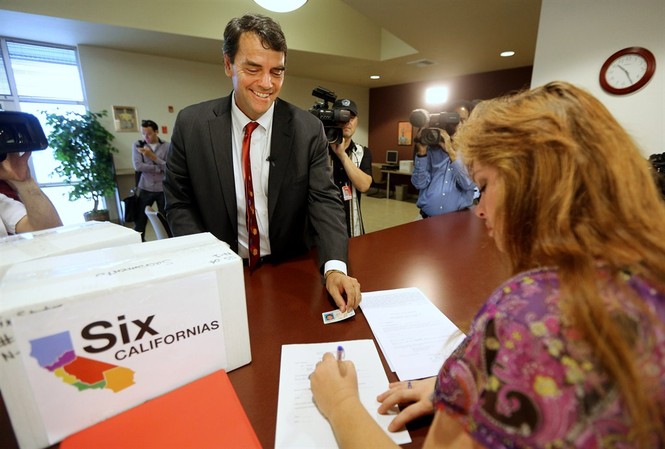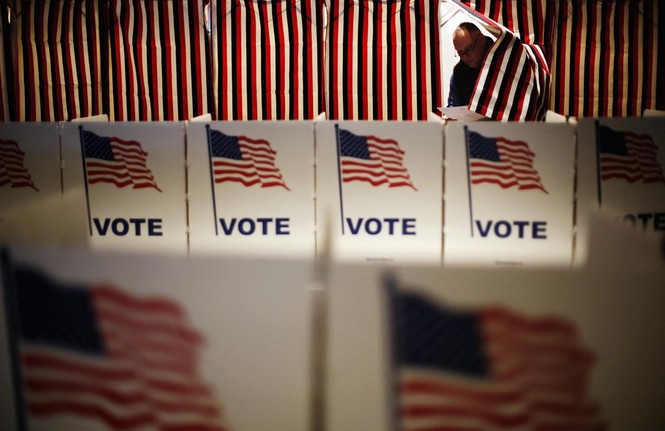As if one California wasn’t enough, we could soon have three Golden States to deal with. On Tuesday, Cal3, a rather ambitious proposal to divide the 168-year-old state into three separate entities, will officially appear on the November 6 ticket.
If a majority of voters cast ballots in favor of the initiative, California will become the first state to split itself since West Virginia came into being in 1863.
Why Three States?

Billionaire venture capitalist Tim Draper, who is sponsoring the measure, explained to The LA Times why he thinks Cal3 is the way to go.
“Three states will get us better infrastructure, better education and lower taxes,” he says. “States will be more accountable to us and can cooperate and compete for citizens.”
On the Cal3 website, they make it known that California is currently 49th in road quality, 41st in transportation, 44th in education, and 46th when it comes to taxes—not exactly a stellar report card.
“[V]ast parts of California are poorly served by a representative government dominated by a large number of elected representatives from a small part of our state, both geographically and economically,” Draper added.
If all goes as planned, the Golden State will be transformed into Northern California, California and Southern California.
Draper insists that California’s current population will be split somewhat evenly among the three states, and that the median household income will be roughly the same for each.
The Breakdown

As mentioned earlier, the proposal aims to split California into three states; one in the North, one in the South, and one somewhat in the middle along the coast. Here’s what each state will look like, according to the campaign’s website.
Recommended
Northern California:
Population: 13.3 million
Counties: 40 (Alamdeda, Alpine, Amador, Butte, Calaveras, Calusa, Contra Costa, Del Norte, El Dorado, Glenn, Humboldt, Lake, Lassen, Marin, Mariposa, Mendocino, Merced, Modoc, Napa, Nevada, Placer, Plumas, Sacramento, San Francisco, San Joaquin, San Mateo, Santa Clara, Santa Cruz, Shasta, Sierra, Siskiyou, Solano, Sonoma, Stanislaus, Sutter, Tehama, Trinity, Tuolumne, Yolo, Yuba)
Median Household Income: $63,000
Leading Industries: Agriculture, High Tech Manufacturing, Trade & Tourism, Forestry
California:
Population: 12.3 million
Counties: 6 (Los Angeles, Monterey, San Benito, San Luis Obispo, Santa Barbara, Ventura)
Median Household Income: $53,000
Leading Industries: High Tech Manufacturing, Motion Pictures, Tourism, Forestry
Southern California:
Population: 13.9 million
Counties: 12 (Fresno, Imperial, Inyo, Kern, Kings, Madera, Mono, Orange, Riverside, San Bernardino, San Diego, Tulare)
Median Household Income: $45,000
Leading Industries: Agriculture, Varied Manufacturing, Trade & Wholesale, Financial Services
Past Attempts

This isn’t the first time Draper has tried to split California into multiple states, but it is the first time his plan has made it on the ballot. In 2014 the venture capitalist attempted to divide the Golden State into six separate entities, but there were major economic concerns.
Draper insists this time that each of the three states will be able to develop sustainable economies, highlighting the major industries that will drive each one (listed above).
Regardless, Draper’s past proposal didn’t attract enough signatures to be put on the 2016 ballot. He came close, but many of the signatures were later invalidated.
This time around, Cal3 earned approximately 600,000 signatures—and so far 402,468 have been validated. In order to appear on the ballot in California, an initiative needs 366,880 signatures.
While Draper finally seems to be getting somewhere with his plan, he’s certainly not the first Californian to try and partition the West Coast state.
Attempts to break up California date back all the way to 1855, a mere five years after the territory was admitted to the Union. Since then there have been over 200 attempts to divide the state or have it succeed from the U.S.
In January, we also saw the introduction of New California. The idea, developed by conservative radio talk show host Robert Paul Preston, is to split California into two states, one rural, one urban.
And in the Spring, we saw Yes California, more commonly known as Calexit, once again picking up steam. They currently do not have enough signatures to appear of the 2018 ballot, but have until October 20 to get their numbers up.
What Happens If Voters Approve?

If a majority of Californians say “yes” to Cal3 (and that’s a big “if”—an April poll found that 72 percent of voters are opposed the idea of splitting the state into thirds), then the proposal will move on to Congress. However, if it does miraculously make it to the Capitol, it doesn't look like it will survive long, given the cost and chaos it will create. Adding in two new states means four new Senators and redrawing the electoral map. While Northern California and California would likely remain blue, analysts believe Southern California would become a swing state.
What do you think, is it time for a few new states? Or should California leave all together?

























Join the conversation as a VIP Member